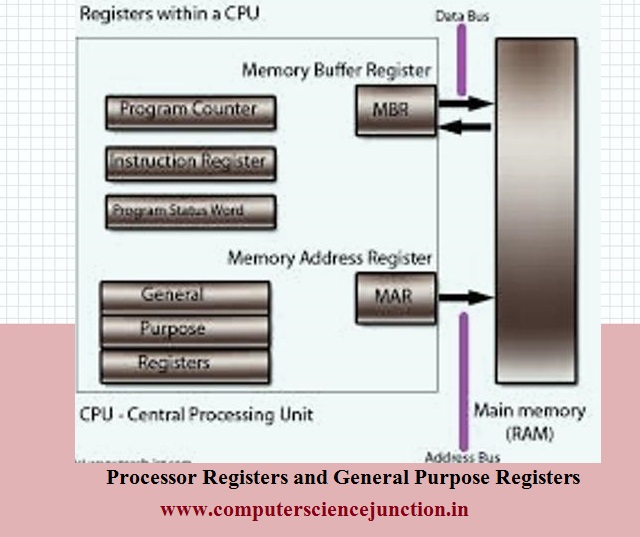Different types of registers in computer organization of a modern computer system are available now a days. These registers play a vital role in storing a small amount of data.
Questions based on registers and types of registers in computer are generally asked in interviews and practical examination viva voce. So computer science students should have knowledge about the basic concepts of registers.
This tutorial is specially prepared for students to provide them a better understanding of the registers. In this tutorial, students will learn about register introduction and different types of registers in computer.
Types of registers in computer explained in this tutorial re as follow –
- Program Counter Registers (PC)
- Memory Address Registers (MAR)
- Memory Data Registers (MDR)
- Instruction Registers(IR)
- Memory Buffer Registers (MBR)
- Accumulator (AC)
- User Accessible Registers
Also Read – Application of Image Processing
Table of Contents
- 1 Frequently Asked Questions
- 2 What is a Computer Register?
- 3 Types of Registers in Computer Architecture
- 4 2 – User-Accessible Register
- 5 Differences between the two types
- 6 Applications of Registers
- 7 Conclusion and Summary
Frequently Asked Questions
Some frequently asked questions from types of register in computer are listed below. By the end of this tutorial, the student will able to answer the following questions
- What is a register ?
- What are registers in computer ?
- What are the different types of registers in computer architecture?
- What is the accumulator?
- What is Program Counter?
- Write the difference between MAR and MBR.
- What is the Index register?
- What are the different phases of instruction?
- What do you understand by addressing mode?
- What are Opcode and Operand?
Also Read – C Programming Questions for Practice
What is a Computer Register?
What is register in microprocessor ? Some time this question is asked in viva voce or in technical interview. Let’s understand the registers definition.
Registers hold an important position in computer architecture. These are the temporary storage area in the computer, where the newly fetch data is stored.
A register is a sequential circuit. Registers are a group of flip-flops where each flip-flop stores one bit of information.
An n-bit register contains the n-flip-flops which are capable of storing information in bits. These are responsible for storing data as an when needed.
A Registers as a whole has both flip-flops and Gate. Flip-flops store the bits of information as and when needed while Gate is responsible for transferring the information to the register.
There are various types of register in computer available in the market containing both the flip-flops and registers. But some of the simplest and best registers usually contain only the flip-flop.
Registers differ in the bit-operations within the computer architecture. Some of the registers are 8-bit, 16-bit, 32-bit, and now we have 64-bits also.
These registers differ in the operations like fetching the instructions. A 32-bit register can fetch 32 bits of information at a time, also it can process 32-bit of information only.
Also Read – String in C Programming
Key Point 1- Register is not only used for storing the data but also used to accept and transfer the data quickly.

Types of Registers in Computer Architecture
There are two types of registers in computer architecture. Some registers are internally in the processor while the other one is user-accessible.
These two types of registers in computer architecture differ in their accessibility to computer architecture.
1 – Internal Registers or CPU Registers
As the name suggests, these types of registers in computer architecture are used in the processor internally. Internal registers are also known as processor registers.
These registers are used by CPU to perform various operations or during the different phases of an instruction such as fetch, decode, and execute. This is the function of register which belong to microprocessor.
-
Fetch
During the fetch phase, an instruction is fetched from the memory.
-
Decode
Once the instruction is fetched from memory after that instruction is decoded so that instruction can be interpreted. In this phase, CPU finds out the operation to be performed and this operation is denoted by an opcode.
-
Execute
Once the operation is identified during the decoding phase then the arithmetic and logical unit perform that operation and the result is stored in memory from where the result is displayed to the user.
Here the data and the instructions are fetched internally and are sent to the processor directly within the processor.

Types of CPU Registers in Computer Organization
Different types of registers in computer microprocessors or types of cpu registers are as follow –
1. Program Counter Register
Program Counter Register holds the address of the next instruction to be fetched. Instruction is fetched from the address specified by the Program Counter (PC).
Once the instruction is fetched then the value with each operation PC increments its value.
2. Memory Address Register
The address specified by the PC first goes to another register known as memory address register. CPU finds this address from MAR to read the instruction or data from memory.
If CPU wants to write some data in memory then at which address this data will be written then this address is also specified by MAR.
It means MAR simply stores the address from which CPU needs to fetch the instruction or data and also store the address where the data will be store in memory.
Also Read – NIST Cloud Computing Reference Architecture
3. Instruction Register
Once the instruction is fetched from memory then fetched instruction is stored in Instruction Register, Decoder is connected with this instruction register and decode the fetched instruction.
4. Memory Buffer Register (MBR)
This register is used for buffering of the memory so that instruction is not halted abruptly to the processor
5. Memory Data Register (MDR)
When an instruction is decoded then we get the information about opcode, mode, and address field. This address field provides the information either directly or indirectly about the address of the operand.
When the operand address is found out the operand is fetched from that address and this operand is stored in a register known as memory data register.
6. Accumulator
An accumulator is a type of registers that are used by CPU. This accumulator acts as a temporary storage location which holds an intermediate value in mathematical and logical calculations.
Also Read – The Wendy William Show Final Episode
2 – User-Accessible Register
The second type of registers is important for computer architecture in enabling the accessibility to the instructions and fetch signals.
These registers are also known as general-purpose registers. It has a larger size as compared to the internal registers, hence these registers stores and perform operations larger than the internal registers.
Despite being larger in size in terms of memory, these registers take a longer time than the taken usually by the internal registers in performing its operation.
These registers include the Data register, responsible for temporarily storing the data being transmitted from one peripheral device to another.
Also Read – C Programming GATE Questions and Answers
An opcode represents the operation to be perform executed by the CPU. In Computer Architecture opcode is denoted in assembly language in mnemonic form. This opcode is also known as a command.
For example, consider the following instruction
ADD R1, R2
The opcode is the ADD which represents that we addition of values stored in register R1 and register R2 should be performed.
The operand is the data on which the operation is going to be executed by the CPU. Aa in the above instruction Operands are the values stored in register R1 and register R2.
The operand may be data value stored in memory at some address.
Differences between the two types
Both the types of registers the Internal register and the User-accessible register perform the same operation of fetching the instruction signals to the processor and holding the primary memory for a small time.
They differ in the size, as an internal register has a larger size than that of the user-accessible register. Also, these two registers differ in terms of the time of execution, as the user-accessible register is readily available for fetching instructions it takes a shorter time than that of the internal registers.
Applications of Registers
Registers are responsible for the fetching of the instructions from the program to the processor, thereby running the whole computer architecture.
They provide the memory space for the instructions to be stored at the earliest time possible.
These registers increase the efficiency of the different operations like pipelining and hence provide speed to the operations in the program in the computer architecture.
Conclusion and Summary
We have learned about the basics concepts of registers. Different types of registers in computer organization are also discussed here in this tutorial. The application or use of each type of registers is also discussed here in this tutorial.
Important for Student – To Learn Computer Architecture and practice GATE(CS/IT) Exam questions click at the link given below
computer architecture tutorial
Thanks!

